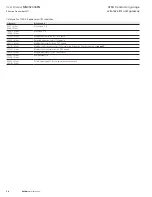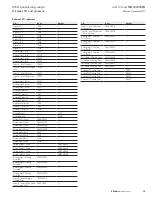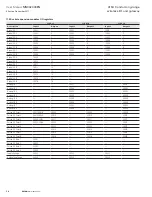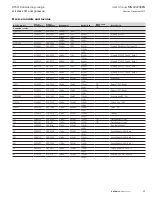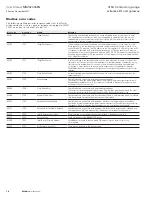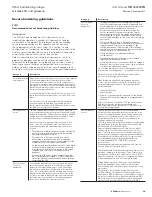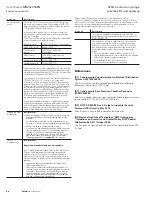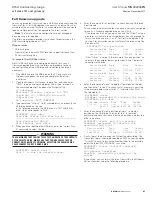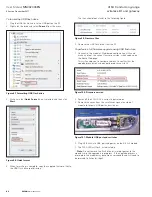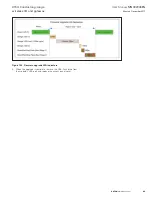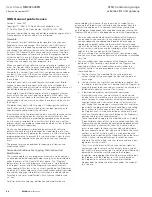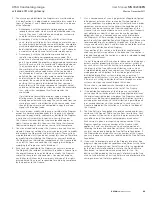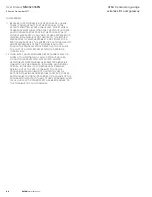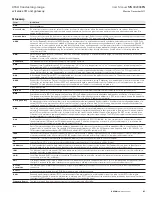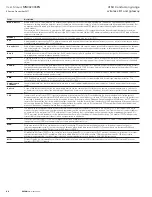
88
User Manual
MN032006EN
Effective December 2017
415U Condor-long-range
wireless I/O and gateway
EATON
www.eaton.com
Term
Definition
MAC Address
Media Access Control (MAC) address is a unique code assigned to most forms of networking hardware. The address is permanently assigned to the
hardware, so limiting a wireless network’s access to hardware (such as wireless cards) is a security feature employed by closed wireless networks. But
an experienced hacker armed with the proper tools can still figure out an authorized MAC address, masquerade as a legitimate address, and access a
closed network.
Every wireless 802.11 device has its own specific MAC address hard-coded into it. This unique identifier can be used to provide security for wireless
networks. When a network uses a MAC table, only the 802.11 radios that have had their MAC addresses added to that network’s MAC table will be able
to get onto the network.
Modbus
Modbus is a serial communications protocol for use with its programmable logic controllers (PLCs).
PLC
A programmable logic controller (PLC) is a digital computer used for automation of electromechanical processes, such as control of machinery on factory
assembly lines, amusement rides, or light fixtures.
Proxy Server
Used in larger companies and organizations to improve network operations and security, a proxy server is able to prevent direct communication between
two or more networks. The proxy server forwards allowable data requests to remote servers and/or responds to data requests directly from stored
remote server data.
RJ-45
Standard connectors used in Ethernet networks. RJ-45 connectors are similar to standard RJ-11 telephone connectors, but RJ-45 connectors can have
up to eight wires, whereas telephone connectors have four.
RTU
A remote terminal unit (RTU) is a microprocessor-controlled electronic device that interfaces objects in the physical world to a distributed control system
or SCADA system by transmitting telemetry data to a master system, and by using messages from the master supervisory system to control connected
objects.
SCADA
SCADA (supervisory control and data acquisition) is a type of industrial control system (ICS). Industrial control systems are computer controlled systems
that monitor and control industrial processes that exist in the physical world. SCADA systems historically distinguish themselves from other ICS systems
by being large scale processes that can include multiple sites, and large distances.
Server
A computer that provides its resources to other computers and devices on a network. These include print servers, Internet servers and data servers. A
server can also be combined with a hub or router.
SMA
SMA (SubMiniature version A) connectors are semi-precision coaxial RF connectors for coaxial cable with a screw type coupling mechanism. The
connector has a 50 Ω impedance. It is designed for use from DC to 18 GHz.
Sub Network
or Subnet
Found in larger networks, these smaller networks are used to simplify addressing between numerous computers. Subnets connect together through a
router.
Switch
A type of hub that efficiently controls the way multiple devices use the same network so that each can operate at optimal performance. A switch acts
as a networks traffic cop: rather than transmitting all the packets it receives to all ports as a hub does, a switch transmits packets to only the receiving
port.
TCP
Transmission Control Protocol (TCP) isprotocol used along with the Internet Protocol (IP) to send data in the form of individual units (called packets)
between computers over the Internet. While IP takes care of handling the actual delivery of the data, TCP takes care of keeping track of the packets that
a message is divided into for efficient routing through the Internet. For example, when a Web page is downloaded from a Web server, the TCP program
layer in that server divides the file into packets, numbers the packets, and then forwards them individually to the IP program layer. Although each packet
has the same destination IP address, it may get routed differently through the network. At the other end, TCP reassembles the individual packets and
waits until they have all arrived to forward them as single message.
TCP/IP
The underlying technology behind the Internet and communications between computers in a network. The first part, TCP, is the transport part, which
matches the size of the messages on either end and guarantees that the correct message has been received. The IP part is the user’s computer address
on a network. Every computer in a TCP/IP network has its own IP address that is either dynamically assigned at startup or permanently assigned. All
TCP/IP messages contain the address of the destination network as well as the address of the destination station. This enables TCP/IP messages to be
transmitted to multiple networks (subnets) within an organization or worldwide.
TTL
Transistor–transistor logic (TTL) is a class of digital circuits built from bipolar junction transistors and resistors. It is called TTL logic because both the
logic gating function (AND) and the amplifying function are performed by transistors.
WAN
Wide area network (WAN) is a communication system of connecting PCs and other computing devices across a large local, regional, national or
international geographic area. Also used to distinguish between phone-based data networks and Wi-Fi. Phone networks are considered WANs and
Wi-Fi networks are considered Wireless Local Area Networks (WLANs).
WEP
Wired Equivalent Privacy (WEP) is a basic wireless security provided by Wi-Fi. In some instances, WEP may be all a home or small-business user needs
to protect wireless data. WEP is available in 40-bit (also called 64-bit), or in 108-bit (also called 128-bit) encryption modes. As 108-bit encryption
provides a longer algorithm that takes longer to decode, it can provide better security than basic 40-bit (64-bit) encryption.
Wi-Fi
Wireless Fidelity. An interoperability certification for wireless local area network (LAN) products based on the Institute of Electrical and Electronics
Engineers (IEEE) 802.11 standard.

